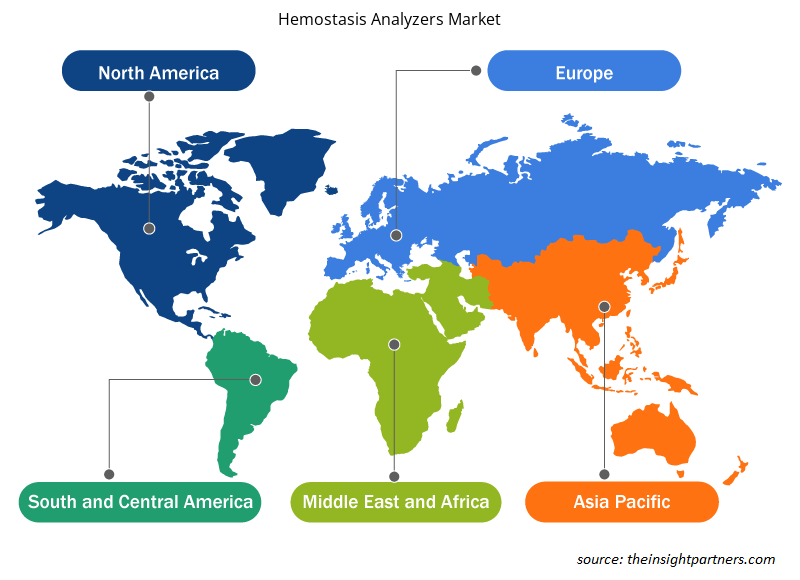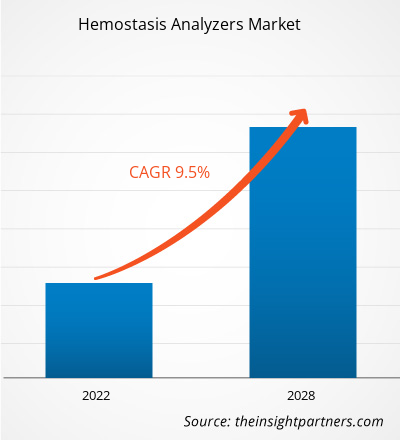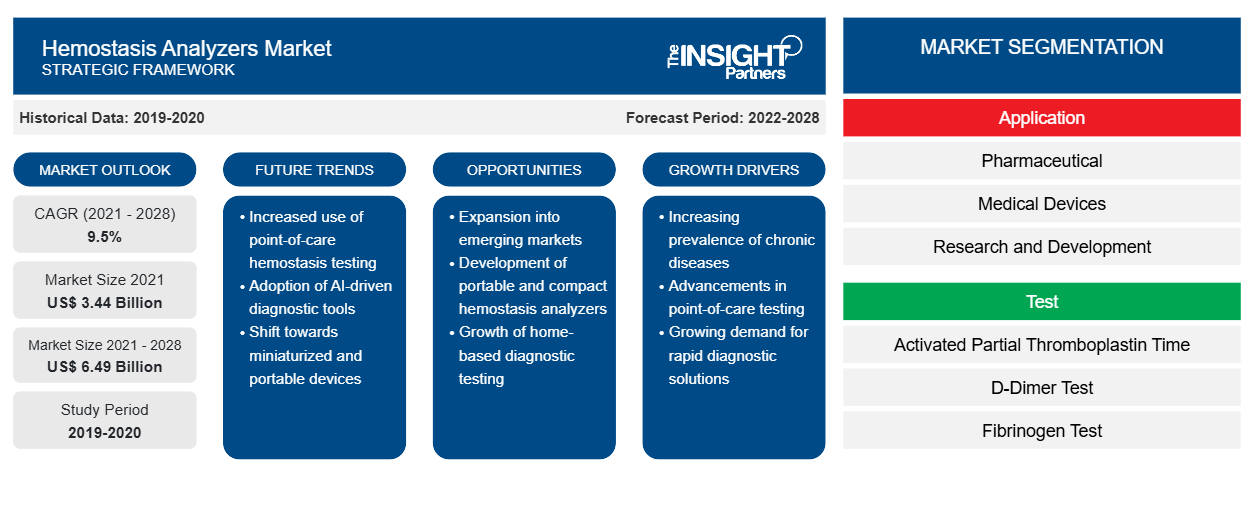Si prevede che il mercato degli analizzatori dell'emostasi raggiungerà i 6.490,24 milioni di dollari entro il 2028, rispetto ai 3.440,66 milioni di dollari del 2021; si prevede che registrerà un CAGR del 9,5% dal 2021 al 2028.
Gli analizzatori di emostasi forniscono una misurazione rapida e semplice dei livelli di piastrine nel sangue. Un test di coagulazione potrebbe aiutare a rilevare e prevenire i coaguli di sangue che potrebbero causare un infarto. Un analizzatore di coagulazione può misurare la velocità del percorso di coagulazione e le quantità di trombolina e tromboplastina in meno di pochi minuti. Le malattie cardiovascolari (CVD) probabilmente rimarranno la causa più significativa di morbilità e mortalità in tutto il mondo. Le CVD sono disturbi del cuore e dei vasi sanguigni e includono malattie cerebrovascolari, malattie coronariche, malattie cardiache reumatiche e altre condizioni. Alcuni problemi correlati allo stile di vita che portano a malattie cardiovascolari e difficoltà sono l'uso di tabacco, una dieta non sana e l'inattività fisica. Aumentano il rischio di infarti e ictus. Altri fattori di rischio per le malattie cardiovascolari sono l'ipertensione, il diabete e l'aumento dei livelli di colesterolo. Secondo l'Organizzazione mondiale della sanità (OMS), le malattie cardiovascolari sono la prima causa di morte a livello globale.
Personalizza questo report in base alle tue esigenze
Riceverai la personalizzazione gratuita di qualsiasi report, comprese parti di questo report, o analisi a livello nazionale, pacchetto dati Excel, oltre a usufruire di grandi offerte e sconti per start-up e università
- Scopri le principali tendenze di mercato in questo rapporto.Questo campione GRATUITO includerà analisi di dati che spaziano dalle tendenze di mercato alle stime e alle previsioni.
Market Insights
L'aumento della popolazione geriatrica guiderà il mercato degli analizzatori di emostasi
Le persone anziane sono inclini alle malattie cardiache a causa della debole immunità e di altri problemi di salute. I fattori generali dell'invecchiamento portano all'irrigidimento del cuore e dei vasi sanguigni che provocano disturbi cardiaci. Con l'avanzare dell'età, aumenta anche la pressione sanguigna sistolica, portando a malattie cardiovascolari (CVD). Pertanto, nelle persone di età pari o superiore a 75 anni, l'ipertensione è un fattore di rischio comune per le malattie cardiache. La malattia coronarica e l'insufficienza cardiaca sono gli altri. Sebbene l'incidenza delle aritmie comprenda persone di tutte le fasce d'età, sta aumentando in modo significativo tra la popolazione geriatrica. Secondo il sondaggio Global Ageing 2019, la popolazione mondiale di 65 anni e oltre ha totalizzato 703 milioni nel 2019. Si prevede che la fascia demografica degli anziani raddoppierà fino a raggiungere 1,5 miliardi di persone entro il 2050. La frequenza di una persona di 65 anni o più aumenterà probabilmente da 1 su 11 abitanti nel 2019 a 1 su 6 abitanti entro il 2025. Questa fascia demografica è più suscettibile alle malattie cardiovascolari, come le aritmie. Analogamente, secondo l'Organizzazione mondiale della sanità (OMS), si stima che la percentuale di persone di età pari o superiore a 60 anni raggiungerà il 22% entro il 2050 dal 12% nel 2015. Secondo il rapporto "Older Americans 2016: Key Indicators of Well-Being" del Federal Interagency Forum on Aging-Related Statistics, il 35,8% degli individui di età pari o superiore a 85 anni ha avuto un disturbo cognitivo lieve o estremo. Inoltre, secondo il rapporto delle Nazioni Unite sull'invecchiamento della popolazione mondiale del 2017, nel 2017, 962 milioni di persone avevano 60 anni o più in tutto il mondo e si prevede che il numero raggiungerà quasi 2,1 miliardi entro il 2050. La popolazione anziana è più incline a presentazioni atipiche, condizioni comorbide e risultati sfavorevoli. La ragione principale delle malattie è correlata ai cambiamenti strutturali e funzionali nel sistema cardiovascolare associati all'invecchiamento. L'aumento della popolazione geriatrica globale sta portando a un'impennata delle malattie cardiovascolari, che, a sua volta, sta spingendo la domanda di analizzatori di emostasiCVDs). Thus, in people aged 75 years and above, high blood pressure is a common risk factor for heart conditions. Coronary artery disease and heart failure are the others. Although the incidence of arrhythmias encompasses people of all age groups, it is rising significantly among the geriatric population.
Ageing 2019 survey, the world's population of 65 years and above totaled 703 million in 2019. The senior demographic is expected to double to 1.5 billion people by 2050. The frequency of one person with age 65 or more is likely to increase from 1 in every 11 inhabitants in 2019 to 1 in every 6 inhabitants by 2025. This demographic is more susceptible to CVDs, such as arrhythmias. Similarly, according to the World Health Organization (WHO), the percentage of people aged 60 and above is estimated to reach 22% by 2050 from 12% in 2015. As per the report "Older Americans 2016: Key Indicators of Well-Being" by the Federal Interagency Forum on Aging-Related Statistics, 35.8% of individuals aged 85 and above had a mild or extreme cognitive disorder. Moreover, according to the United Nation's World Population Ageing 2017 report, in 2017, 962 million people were aged 60 years or over worldwide, and the number is expected to reach nearly 2.1 billion by 2050.
comorbid conditions, and unfavorable outcomes. The primary reason for the diseases is related to the structural and functional changes in the cardiovascular system associated with aging. The rise in the global geriatric population is leading to a surge in cardiovascular diseases, which, in turn, is propelling the demand for hemostasis analyzers
Informazioni basate sul tipo di prodotto
In base al tipo di prodotto, il mercato degli analizzatori di emostasi analyzers market è ulteriormente segmentato in analizzatori di laboratorio e sistemi di test point-of-care . Nel 2021, il segmento degli analizzatori di laboratorio detiene la quota maggiore del mercato e si stima che il segmento dei sistemi di test point-of-care registrerà il CAGR più elevato nel periodo 2021-2028.CAGR during 2021–2028.
Quota di mercato degli analizzatori di emostasi, per tipo di prodotto – 2021 e 2028
Approfondimenti basati sui test
In base ai test, il mercato è segmentato in tempo di tromboplastina parziale attivata, test del D-dimero, test del fibrinogeno, test del tempo di protrombina e altri. Nel 2021, il segmento del tempo di tromboplastina parziale attivata ha detenuto la quota maggiore del mercato. Si prevede che il segmento del test del tempo di protrombina registrerà il CAGR più elevato nel mercato durante il periodo 2021-2028.
Informazioni basate sull'utente finale
Based on end users, the market is segmented into hospitals/clinics, independent diagnostic laboratories, home care settings, and others. In 2021, the hospitals/clinics segment accounted for the largest share of the market. The independent diagnostic laboratories segment is expected to register the highest CAGR in the market during 2021–2028.
Companies operating in the hemostasis analyzers market emphasize adopting the strategy of product innovations to meet the evolving customer demands worldwide, which also permits them to maintain their brand name in the global market.
Hemostasis Analyzers Market – Segmentation
The Hemostasis Analyzers market is segmented based on product type, test, and end-user. Based on product type, the hemostasis analyzers market is segmented into laboratory analyzers and point-of-care testing systems. Based on test, the market is further segmented into activated partial thromboplastin time, D-Dimer test, fibrinogen test, prothrombin time test, and others. Based on end-user, the market is segmented into hospitals/clinics, independent diagnostic laboratories, home care settings, and others. In terms of geography, the hemostasis analyzers market is segmented into North America (the US, Canada, and Mexico), Europe (France, Germany, Italy, the UK, Spain, and the Rest of Europe), Asia Pacific (Australia, China, India, Japan, South Korea, and the Rest of APAC), the Middle East & Africa (Saudi Arabia, South Africa, the UAE, and the Rest of MEA), and South and Central America (Brazil, Argentina, and the Rest of SCAM)
Hemostasis Analyzers Market Regional Insights
The regional trends and factors influencing the Hemostasis Analyzers Market throughout the forecast period have been thoroughly explained by the analysts at Insight Partners. This section also discusses Hemostasis Analyzers Market segments and geography across North America, Europe, Asia Pacific, Middle East and Africa, and South and Central America.

- Get the Regional Specific Data for Hemostasis Analyzers Market
Hemostasis Analyzers Market Report Scope
| Report Attribute | Details |
|---|---|
| Market size in 2021 | US$ 3.44 Billion |
| Market Size by 2028 | US$ 6.49 Billion |
| Global CAGR (2021 - 2028) | 9.5% |
| Historical Data | 2019-2020 |
| Forecast period | 2022-2028 |
| Segments Covered | By Application
|
| Regions and Countries Covered | North America
|
| Market leaders and key company profiles |
|
Densità degli attori del mercato: comprendere il suo impatto sulle dinamiche aziendali
Il mercato degli analizzatori emostatici sta crescendo rapidamente, spinto dalla crescente domanda degli utenti finali dovuta a fattori quali l'evoluzione delle preferenze dei consumatori, i progressi tecnologici e una maggiore consapevolezza dei vantaggi del prodotto. Con l'aumento della domanda, le aziende stanno ampliando le loro offerte, innovando per soddisfare le esigenze dei consumatori e capitalizzando sulle tendenze emergenti, il che alimenta ulteriormente la crescita del mercato.
La densità degli operatori di mercato si riferisce alla distribuzione di aziende o società che operano in un particolare mercato o settore. Indica quanti concorrenti (operatori di mercato) sono presenti in un dato spazio di mercato in relazione alle sue dimensioni o al valore di mercato totale.
Le principali aziende che operano nel mercato degli analizzatori dell'emostasi sono:
- Siemens AG
- Laboratorio di strumentazione
- Abate
- Società per azioni
- Società Nihon Kohden
Disclaimer : le aziende elencate sopra non sono classificate secondo un ordine particolare.

- Ottieni una panoramica dei principali attori del mercato degli analizzatori dell'emostasi
Profili aziendali
- Siemens AG
- Laboratorio di strumentazione
- Abate
- Società per azioni
- Società Nihon Kohden
- Thermo Fisher Scientific Inc.
- Diagnostica Roche
- Diagnostica Stago
- Laboratori Helena
- Società internazionale Technidyne.
- Analisi storica (2 anni), anno base, previsione (7 anni) con CAGR
- Analisi PEST e SWOT
- Valore/volume delle dimensioni del mercato - Globale, Regionale, Nazionale
- Industria e panorama competitivo
- Set di dati Excel
Report recenti
Testimonianze
Motivo dell'acquisto
- Processo decisionale informato
- Comprensione delle dinamiche di mercato
- Analisi competitiva
- Analisi dei clienti
- Previsioni di mercato
- Mitigazione del rischio
- Pianificazione strategica
- Giustificazione degli investimenti
- Identificazione dei mercati emergenti
- Miglioramento delle strategie di marketing
- Aumento dell'efficienza operativa
- Allineamento alle tendenze normative





















 Ottieni un campione gratuito per - Mercato degli analizzatori di emostasi
Ottieni un campione gratuito per - Mercato degli analizzatori di emostasi